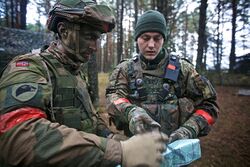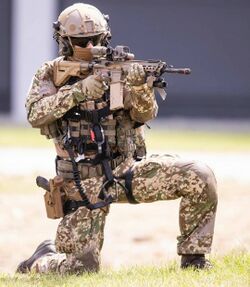Royal Acrean Army
| Royal Acrean Army | |
|---|---|
 | |
| Active | 16 January 1432 - Present |
| Country | |
| Type | Army |
| Size | 562,600 active duty personnel 407,000 National Guard personnel 165,000 reserves 1,134,000 total |
| Part of | Acrean Armed Forces |
| Headquarters | Trier |
| Motto(s) | "Für alles was vi har, und alles was vi er." Acrean Nordic: ""For everything we have, and everything we are" |
| Engagements | Ruvelkan Civil War Great Eracuran War Liberation War Refusal War Zemplen War |
| Commanders | |
| Chief of Defence Staff | Eirik Stordalen |
The Royal Acrean Army is the land warfare branch of Acrea, a part of the Acrean Armed Forces. It is the oldest branch of the armed forces. The official commander-in-chief of the Acrean Armed Forces and therefore the Army is the Crown, however the Chancellor has served as the de facto commander-in-chief on behalf of the Crown since the early 20th Century. The Army is administered by the Ministry of Defence and is led by the Chief of the General Staff.
First established in 1432, the Acrean Army is one of the oldest standing modern armies in Tyran. The formation of a standing Army was done as a consequence of the Ivorian Reforms; the Acrean Empire had been one of the first civilisation to create a standing army, made up of professional soldiers who dedicated years of service before retiring. The first regiments of professional soldiers that were stood up consisted primarily of former Acrean mercenaries. These men were experienced, trained, and favoured the prospect of a regular wage and the accompanying security that came along with it.
The Army is the largest Acrean military branch. It has three main components- the active-duty Army, the Home Guard (Acrean: Heimatvärnet), and the Army Reserve. The active-duty Army consists of the professional regular army, and at the end of 2021 had approximately 581,000 personnel. Conscription for the regular army became unenforced in 1998, as the military's active-duty components moved to an entirely professional force. The Home Guard is the second-largest component, and comprised 328,000 personnel at the end of 2018, and the Army Reserve consisted of 165,000 personnel at the end of 2018. Both the Home Guard and the Army Reserve make up the entire Acrean Army Reserve Forces, with the Home Guard serving as the upper echelon and the Army Reserve as the lower echelon. The Home Guard is kept to a higher readiness and training standard than the Reserve, and are required to attend regular drill training at least once a month, and two-week trainings three times annually. They receive higher priority for equipment, however the equipment is generally second-hand equipment that trickles down from the regular army. Soldiers who are transitioning from active duty service to Home Guard service are allowed to keep their already issued equipment for the duration of their contract. As a consequence of their greater time commitment, Home Guard personnel are also afforded higher pay than the Reserves.
History
Although first founded in 1432, the Acrean Army traces its modern traditions to 1630 and King Leopold IV's martial and social reforms. The Leopoldine Era, in contrast to the Ivorian Era which came three centuries before it, was centered around power rather than the uplifting of society. Although a boon to the Kingdom, the social reorganisation of the Ivorian Reforms and economic prosperity of the Aterlysning brought a fundamental challenge to Leopold IV in the form of social conflict between a still-growing middle class, and the lower noble Junkers. Distinct from the middle and upper classes of the population, as well as from the higher titled nobility, the Junkers constituted their own tightly-knit group of elites who sought to maintain their growing economic dominance at the expense of the high nobility, as well as the middle- and upper-classes.
As the direct owners of much of Acrea's farmland and arable estates, the Junkers had been important in the raising of Acrea's standing army during the late Ivorian era. However, even by the early 1600s this force was still primarily composed of mercenaries in national service, alongside a small core of Acrean soldiers dedicated to the Crown. This force was both wholly unique and inadequate; the steady pay and merit-based hierarchy of the small professional army meant that military service was a genuine and desirable career option for Acrean men, just as the Empire's Army had been a millennia before. At the same time, it was too small to provide Leopold IV with the force that he needed to enforce his power, as mercenaries still provided the Junkers with the ability to create an army of credible threat to the Crown.
Although he and the high nobility possessed the power to take the wealth and estates of the Junkers, Leopold IV was aware that using his power so tyrannically would undoubtedly lead to a very unhappy and potentially rebellious class of lower nobles, who would still possess considerable resources or could outright refuse the Crown's demands. The solution came from Donatien de la Serre, Comte du Villefranche-sur-Mer, a nobleman from Acrea's south. The son of the Archduke of Venetia, de la Serre's solution was termed the Sursis or Friste. In exchange for the payment of a huge sum to the Crown, the King would allow Junkers the ability to rule their estates without direct interference from the Crown or their high nobility.
The Friste was a success, and in turn Leopold used this newly centralised bounty of wealth to re-acquire power and resources from the Junkers and upper class landowners. He first targeted the weaker and more rebellious of the Junker families; with each, they were stripped of much of their wealth, which was subsequently re-invested back in the growth of the army, until it had grown so powerful that the strongest of the Junker families did not need to be physically confronted or challenged to fall in line.
To a lesser extent, the Friste was extended to the high nobility as well. However, in compensation, Leopold generously offered positions and postings within the government and the new army. These positions were not only well-paid but prestigious, reflecting the high opinion of the new, wholly professional army under the Crown's command. For those Junker families who had not engaged in conflict with the common people or treasonous behaviour, they were offered lower positions. Through these actions, Leopold IV successfully tied the well-being and success of the nobility to the state and the Crown. Thus, anyone who was anyone in Acrean society then had an interest in the well-being of the state and, by extension, the army.
With the goals of the Friste completed by 1644, his attention turned to reform of the army which although vastly expanded in size and repute, still followed the model of the Ivorian professional army that was now two centuries old. The army was, for the most part, considered the bastion of what became known of "Acrean Virtues"- traits such as discipline, loyalty, and modesty which had often been quite literally beaten into the men of the army. An army which, Leopold is noted as having observed, was inefficient for a continental power of Acrea's size. In 1648, he instituted the levy, or Landwehr, system. The Landwehr system was the first organised system of conscription in Acrea, and was created with the purpose of not only increasing the number of soldiers available at any given time, but also providing an immense, deep reserve of military-trained men which could be called upon in times of war. The reforms stipulated that all able-bodied men were required to serve at least two years under standard beginning at any point from their nineteenth to their twenty-third birthday, formed into Landwehr regiments which were based locally in the areas from which their manpower originated. These regiments would serve in support of the regular professional army, and would receive training equal to the regular army with the only fundamental difference being their shorter time of service.
The introduction of the Landwehr system was a balancing act for Leopold, but one which proved successful. Numerous changes had to be made to the way in which the army was run and trained, which are often referred to along with the creation of the Landwehr as the Leopoldine Reforms. Punishments were changed from physical ones to jail time and additional intensive drill. Likewise, prospects for advancement into the officer corps were made far, far better for individuals from any strata of society. These changes, combined with the existing prestige and socioeconomic prospects the army could offer, led to a drastic increase in the number of recruits for the professional army. The Landwehr is attributed with being the organisation that gave rise to the idea of "Acrean Virtues", as with the vast majority of men throughout Acrea spending time in the military, the population was gradually infused with these same virtues which came from martial education.
Doctrine
Organisation
Personnel
Rank Structure
|
Generals
|
Field Officers
|
Enlisted
|
Training
Equipment
Weapons
Individual Weapons
The Acrean Army employs two primary service rifles. The first is the M90, first issued in the mid-1980s to replace the older M51. It is supplemented in service by widespread use of the M6, a derivative of the Shalumite StG 64-pattern rifle. Although nominally replaced by the M90 and M06, the M51 remains in regular use across the Acrean Armed Forces. Its standard sidearm is the P93, which replaced the earlier P81. The P81 remains in extensive use by reserve forces and many examples remain in storage. the P93 is supplemented by the P16, an upgraded derivative of the P81 originally intended for use by special forces and select infantry units. In 2017 the option became available for soldiers to select either sidearm. Vehicle crews and light infantry make extensive use of the MP 01 personal defence weapon.
Fire support within a squad comes from a selection of light and general purpose machine guns. The MG59 remains the predominant GPMG in use by Acrean forces, and is being supplemented by the MG15 which will eventually replace it. The MG89 is the only 5.56mm light machine gun in widespread use by any Acrean forces.
Uniforms
Combat Uniforms
The Acrean Army utilises several different designs of uniforms, as well as a variety of camouflage patterns. The most common regular battle dress are Typ-1, and Typ-4, with Typ-3 a specialised cold-weather uniform design and Typ-2 intended for use in hot weather. These are general purpose working uniforms, and possess differences in features and style though maintain the same general profile. The exact uniform a unit uses is often decided at the division level, although in practice all soldiers will possess a set of Typ-1 in addition to any other uniform their division dictates. As each uniform is constructed with different environments in mind, a division's uniform selection is often dependent on their intended area of operations. Selections of uniform type and pattern are often recommended by the Army Group's leadership. In some cases, these logistical decisions are made at the regimental for special-purpose or prestigious regiments. During wartime emergencies, the process of uniform procurement is streamlined, and only two types of uniform are produced for the regular army- a cold weather and hot weather uniform. Reserve units are usually already issued with their particular uniforms, but strategic reserve callups will be issued with whatever uniform is available from the military stockpile.
In addition to different uniform patterns, there is also a wide array of camouflage patterns in use by the Acrean Army. Utilising a variety of camouflage patterns is a common trait of the Acrean Army dating back to the Eracuran Great War, and until the 1980s camouflage was primarily used in the form of patterned smocks and covers rather than being printed onto uniforms. Up until the 1980s, camouflage patterns used were largely holdovers from much earlier patterns which entered service in the 1940s. Additionally, the typical olive-drab grey uniforms were considered to be very desirable for their flexibility; they blended in remarkably well in urban environments (especially in rubble or debris) and could be made to blend into a multitude of environments with the application of dirt, dust, sand, and foliage that accumulated naturally in field operations. Camouflage smocks being used as-desired or as-necessary was considered a cost-effective alternative to uniforms printed with patterned fabric. This reasoning changed beginning in the early 1980s, however the tradition of having a multitude of camouflage patterns never left Acrean military thought, as reflected by the introduction of numerous camouflage patterns into Acrean military service throughout the 1980s and beyond.
There are five common woodland patterns in use in the Acrean Army. The two most common patterns in use are M/83 Waldflecktarnmuster and M/85 Nordtarnmuster. M/83 serves as the primary camouflage pattern for most of the Acrean Army, while M/85 in is the typical pattern in use by troops serving with NORDAG, being specifically developed for use in the lighter foliage and environment of northern Eracura and northern Acrea where the darker-hued M/83 proved to be less effective. Beginning in 2015, a number of Acrean troops have been increasingly issued with M/15 Multiflecktarnmuster, a colour variation of the M/83 pattern meant to be utilised in a variety of different environments. Another distinct variety known as M/89 Fyrretarnmuster is in use with some select units and home guard troops. It is notable for being its own completely separate pattern, rather than others which are simply recoloured varieties of M/83 and M/85. In addition to being printed on uniforms, Fyrretarn is also commonly distributed as a pattern on camouflage smocks. It is specifically designed for use in the frequent, expansive moss-covered pine forests of northern Acrea and northern Eracura, and is considered as supplementary to Nordtarn. Consequently, it is very rare to see in use with regular army units, and is more common among home guard units which are local to areas with such terrain. A similarly uncommon and local pattern is M/93 Camouflage forêt centrale, used solely by the Venetian Legion, which is composed of both Acrean Venetian recruits and Venetian volunteers. Designed in cooperation between the Acrean and Venetian armies, the pattern is used as a symbol of kinship and is worn for distinctiveness rather than particular purpose. It is designed to function in the same environments as the M/83 pattern.


